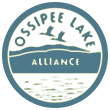Effingham—January 5, 2025—Green Mountain Conservation Group on Friday called for a stormwater management plan to be implemented and monitored at Ossipee Lake’s Wabanaki Campground.
The letter from the organization’s new Executive Director, Nancy Ritger, was directed to Freedom’s Select Board.
Ritger pointed to a 2018 Watershed Management Plan that the non-profit developed with FB Environmental and the N.H. Department of Environmental Services to identify ways to protect the lake’s water quality by treating known sources of nonpoint source pollution.
The section of the lake where Wabanaki Campground is located scored as a medium-high disturbance area, Ritger said, which suggests that best management practices should be implemented along the shoreline to reduce pollutant loads to the lake.
“For these reasons, GMCG encourages the implementation and monitoring of a Stormwater Management Plan to mitigate further degradation of shoreline conditions and to ensure the protection of Ossipee Lake water quality,” Ritger concluded.
GMCG’s letter comes on the heels of similar calls for a stormwater plan made by abutting property owners Maureen and Anthony Raynes and Freedom’s Conservation Commission.
Wabanaki owner/manager Mark Salvati’s plan to convert his 11-acre lakefront business to a 77-unit shareholder-owned cooperative campground requires compliance with Freedom’s municipal regulations before the state will rule on the conversion.
Violations of town regulations at the campground surfaced in Planning Board meeting minutes two years ago, but were not investigated until three weeks ago, when it was revealed that there are 23 violations on the property.
The town has not provided a complete list of the violations, but there is speculation that many of them are in the shoreland buffer, and that has put renewed focus on stormwater management.
A Waiver Request
Stormwater management was first raised by campground agent Horizons Engineering, which asked the Planning Board to waive the requirement for a 100-year stormwater plan for Salvati’s site plan application to improve and expand tent-like “hutnick” structures.
On a site visit to the campground last April, Planning Board members found shoreline erosion and debris being pushed into the lake from runoff. The waiver request was denied, but it sparked a debate over whether to require a stormwater plan for the full property.
Because of a quirk in the Site Plan Review Regulations, however, Salvati was only required to provide a stormwater plan for the “hutnicks,” leaving the larger erosion and runoff issues unaddressed.
Efforts by members of the public to engage the Select Board in a discussion of the campground’s environmental issues have been unsuccessful, with the board directing questioners to the Planning Board.
But the Planning Board has limited its public discussions to the “hutnicks.” After Salvati and his agents were presented with questions by audience members, the Planning Board Chair ruled that “back and forth” questioning of any type would no longer be allowed.
In an apparent effort to resolve the impasse, Conservation Commission Chair Jeff Nicoll hand-delivered a letter to the Planning Board two weeks ago invoking Section 705 of the zoning ordinance as the reason a professional stormwater plan should be required.
Nicoll said the percentage of impermeable surface coverage in the 300 ft. shoreline buffer was 26%. Section 705 of the zoning ordinance requires a professional stormwater management plan if changes are proposed for inside the buffer, and if the buffer’s impervious surface coverage exceeds 25%.
One of the “hutnicks” slated for expansion is inside the buffer. Salvati responded to the Commission’s letter by telling the Planning Board he would remove that “hutnick” from his application.

Thank god for private citizens and non profit conservation groups for staying on top of activities by individuals that would destroy the environment.
The protocols in place are not strict enough to account for sketchy individuals that would exploit the weaknesses of small town governing for self gain. No honor amongst thieves.